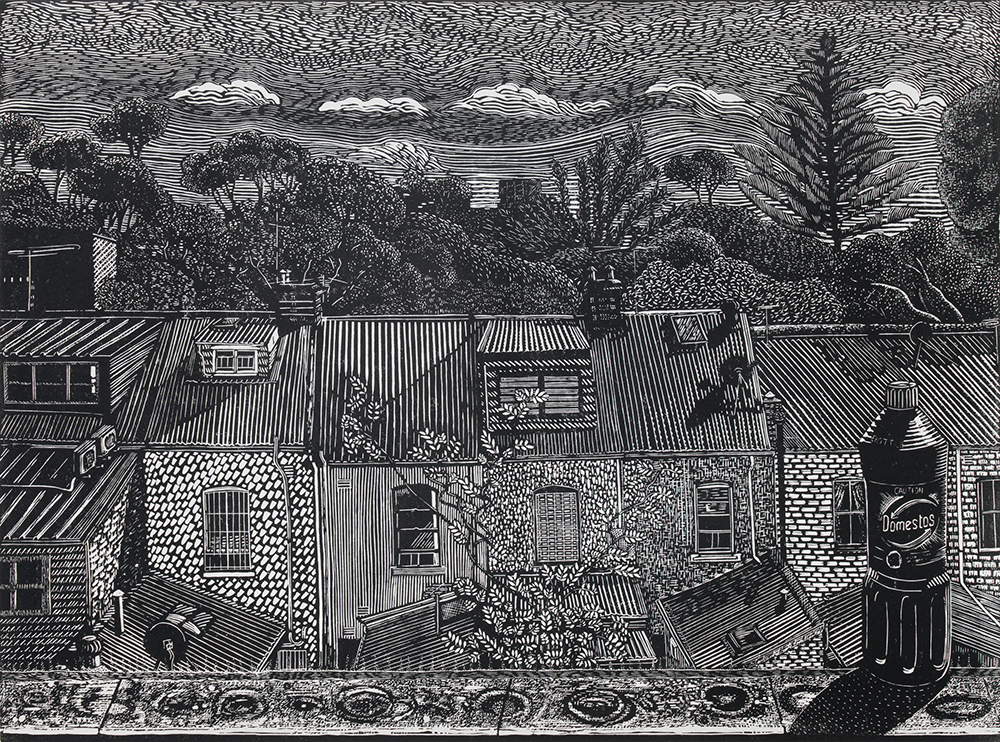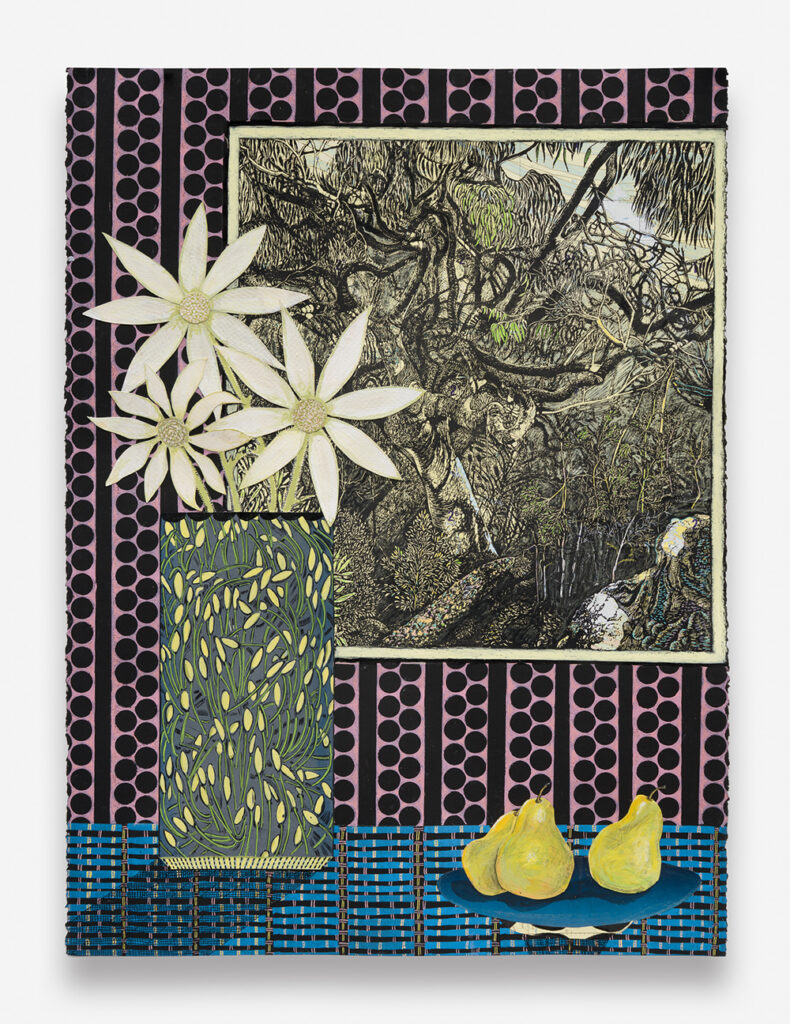Creative Profile: Maggie Stein
Originally from Goulburn, Maggie Stein has been living a creative life for more than three decades and is now firmly based in Sydney’s Inner West. An established artist and passionate educator, Maggie has exhibited widely, sold extensively through exhibitions and commissions, and earned recognition through multiple awards.
In 2019, her work was celebrated with both the People’s Choice Award at the Blue Mountains Print Prize and the Urban Edge Art Award, presented by the Inner West Council. Working from her Marrickville studio, Maggie creates original lino prints, each one meticulously hand-printed using archival inks on acid-neutral Japanese and European papers.
You grew up in a 1920s house with beautifully ornate plaster ceilings and tessellated tiles. Has this spurred your interest in the past history of buildings?
I took my surroundings for granted as a child but I came to realise my home was quite unique. My parents married late and we lived there with my grandmother, amongst furniture from a previous time and cabinets full of special crockery and crystal. An early tactile memory is one of running my fingers along the velvety pile on an ornate ottoman on our closed in verandah. While I was subconsciously influenced by my immediate surroundings, I distinctly remember wanting a modern ‘70s style home with the furniture and clothes to match.
As well as our house in town my father had inherited the family farm, including a beautiful bluestone house that his father and uncle built by hand early last century. The story went that the brothers took a load of wood to Kenmore (a psychiatric hospital) every day and returned with a load of stone to build another wall. Looking and feeling those walls as a kid made an impression on me. Even though I didn’t meet my forbears, I felt a connection through the stone.

Architecture is a strong preoccupation in your work. What are you trying to say about your emotional connection with buildings ?
On Sundays I would walk the streets of town with my mother and sister, invariably stopping for our mother to chat to people (for far too long). She seemed to know who lived in each house in the parts of town we frequented, so I came to understand that buildings held stories even if we didn’t see the occupants. Coming from a town with a rich architectural history, I think I became unconsciously drawn to inner west buildings. Their walls held stories. I seek to capture not only the architectural details, facades and proportions of buildings but the scars, ghost signs and weathered surfaces that reveal clues to past lives.
How would you describe the special quality of Sydney’s inner west ?
I have lived in Newtown for 24 years now. There is an ease of existence here for me.
I appreciate the community feeling, its inclusiveness, left leaning politics, colour, grittiness, history and stories. There is an abundance of historic structures and landmarks. It’s a tightly packed space with almost everything I need in walking distance from home.
Why have you chosen linocut as your preferred medium of expression ?
In 2005 I was asked by our school community to make an art work for a local family moving to regional NSW. It came to me to make a lino print which I hadn’t done for a long time. The response to the image was overwhelmingly positive and it set me on a path to make more prints. I found printmaking to be really accessible. At this time my kids were 5,7 and 10 years old. I was time poor and financially strapped. I could make work on the kitchen table and that's what I did for a few years. Linoleum has a quality that really lends itself to expressing grit and character, perfect for the subject.
You seem to have an equal interest in patterns in nature. Do you love pattern and texture because they help you deal with complexity ?
Like most people, I find it hard not to get bogged down in detail. I love to observe and appreciate patterns and textures in all environments. It can seem like a long process to translate any image from real life into a lino print. The thing about working in nature is that I can work directly onto the lino. There’s no need to reverse the image, which is a must for depicting text or well-known buildings. This immediacy breathes life into the work; it pushes me to find spontaneous marks that express a pattern or the play of light on form. Pattern is soothing. I find repeating patterns in my art and in my actions a comfort.
You are a swimmer, cyclist and yoga practitioner. Does challenging the capacity of your body influence your art practice ?
My daily exercise regime is like a ritual. I accept it as part of my routine. It's essential to keep my body and mind in its best possible form to make the most out of my life for myself, others and this world. Focusing on breathing, when swimming takes me to a space where thoughts flow freely and fresh ideas can emerge, problems have solutions or wither in their significance. I am aware of the endorphin hit I get from swimming which helps me feel buoyant for hours, until I get very tired, just after lunch !
My work habits are rigorous. The act of carving and printing large linos and standing, making other work is taxing on the body. These days with more insight, I'm actually trying to be kinder to myself by recognising when I'm at a loss in my creative flow, I will take a break and do something to recharge.

What do you gain from sharing a space with other creatives in May Street Studios?
I find it essential to have my own space to work in. My current space is really great for several reasons: it’s very quiet; it’s bright; and the air con means I can work comfortably all year round. Being amongst like-minded people gives me a boost. I love connecting with other artists who also turn up regularly. It's especially good to talk to people who have similar goals, like exhibiting, collaborating and entering competitions. On the other hand, because my teaching days are very busy, I am also happy to not see people at the studio. I love the silence! I’m currently organising an open studio event with some of the May Street artists. I love being part of the community and enabling visitors to come to my studio. As a relative newcomer, this has been a great way to build relationships.
As a primary school art specialist, what do you want children to learn ?
At school I’m the art teacher, but also a gardener, sustainability leader, knitting teacher etc. I love being able to pass on my passion to the next generation. It’s such an honour to teach the very young; it’s a win-win situation. I see my role as an art educator as one of being a facilitator for my students’ creative expression and agency. I believe we are all creative beings at our core and the physicality and play of creating is a real contrast to what goes on in their regular classes.
I hope my students see through me, that making is for everyone; that small things in our world can bring joy. I model slowing down and learning to observe in a non-judgemental, safe and inspiring environment.
Article by Tamara Winikoff
Tamara Winikoff is an independent consultant with extensive experience in arts advocacy, policy, and cultural leadership. She was a a founding member of the Inner West Creative Network and served as Executive Director of the National Association for the Visual Arts (NAVA) for 22 years, championing artists' rights and sector development. As Co-convenor of ArtsPeak, she coordinated national arts policy initiatives. Previously, she managed the Community, Environment, Art and Design (CEAD) program at the Australia Council for the Arts and lectured in Cultural Environment and Heritage at Macquarie University. Based in Sydney, she continues to influence the cultural landscape through strategic consultancy.
